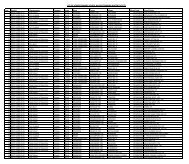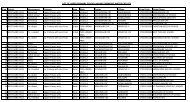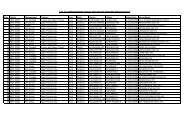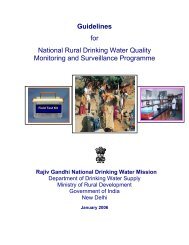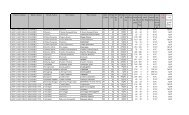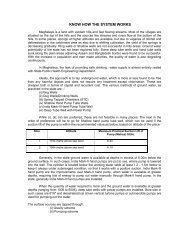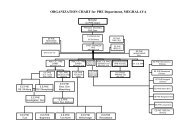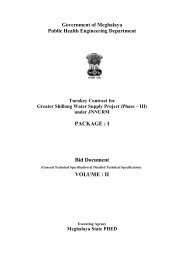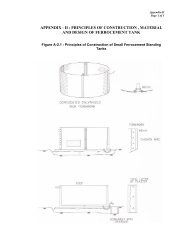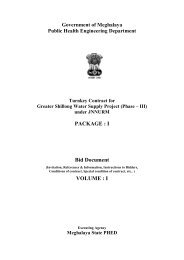PRESTRESSED CONCRETE PIPES While RCC pipes can cater to ...
PRESTRESSED CONCRETE PIPES While RCC pipes can cater to ...
PRESTRESSED CONCRETE PIPES While RCC pipes can cater to ...
Create successful ePaper yourself
Turn your PDF publications into a flip-book with our unique Google optimized e-Paper software.
<strong>PRESTRESSED</strong> <strong>CONCRETE</strong> <strong>PIPES</strong><br />
<strong>While</strong> <strong>RCC</strong> <strong>pipes</strong> <strong>can</strong> <strong>cater</strong> <strong>to</strong> the needs where pressures are up<strong>to</strong> 3.0Kg/cm2 and C.I and steel<br />
<strong>pipes</strong> <strong>cater</strong> <strong>to</strong> the needs of higher pressures around 24 Kg/cm2, the P.S.C <strong>pipes</strong> <strong>cater</strong> <strong>to</strong><br />
intermediate pressure range for which the metallic <strong>pipes</strong> are expensive while <strong>RCC</strong> <strong>pipes</strong> would<br />
not be suitable . The strength of a P.S.C pipe is achieved by helically binding high tensile steel<br />
wire under tension around a concrete core there by putting the core in<strong>to</strong> compression. When the<br />
pipe is pressurised the stresses induced relieve the compressive stress but they arae not sufficent<br />
<strong>to</strong> subject the core <strong>to</strong> tenslie stresses. The prestressing wire is protected against corrosion by a<br />
surround of cementatious cover coat giving at least 25mm of cover<br />
P.S.C competes economically with steel for pipe diameters of 600 mm and above. It is a unique<br />
combination of durability of concrete and high strength of steel combined with economy in raw<br />
materials. The P.S.C <strong>pipes</strong> are ideally suited for water supply mains where pressures in the range<br />
of 6 Kg/cm2 <strong>to</strong> 20 Kg/cm2 are encountered.<br />
Two types of P.S.C <strong>pipes</strong> are in use <strong>to</strong>day.<br />
• Cylinder type: Consists of a concrete lined steel cylinder with steel joint rings welded <strong>to</strong><br />
its ends warpped with a helix of highly stressed wire and coated with dense cement<br />
mortar concrete.<br />
• Non cylinder type: Consists of a concrete core which is pre-compress both in<br />
longitudinal and circumferential directions by a highly stressed with the wire wrapping is<br />
protected by coat of cement mortar or concrete.<br />
Physical behaviour of P.S.C <strong>pipes</strong> under internal and external load is superior <strong>to</strong> R.C.C <strong>pipes</strong>.<br />
The P.S.C pipe wall is always in a strength of compresion which is the most favourable fac<strong>to</strong>r<br />
for impermeability. These <strong>pipes</strong> <strong>can</strong> resist high external loads. The protective cover cement sand<br />
mortar which covers the tensions wire wrapping by its ability <strong>to</strong> create and maintain alkaline<br />
environment around the steel inhibits corrosion. P.S.C <strong>pipes</strong> are jointed with flexible rubber<br />
rings. The deflection possible during laying main is relatively small and the <strong>pipes</strong> <strong>can</strong>not cut <strong>to</strong><br />
size <strong>to</strong> close gaps in the pipeline. Special closure units (consisting of a short double space piece<br />
and a plain ended concrete lined steel tube with a follower-ring assembled at each end)are<br />
manufactured for this purpose, the closure unit(minimum length 1.27m) must be ordered<br />
specially <strong>to</strong> the exact length.<br />
Specials such as bends, bevel <strong>pipes</strong>, flanged tees tapers and adapters <strong>to</strong> flange the couplings are<br />
generally fabricated as mild steel fittings lined and coated with concrete. It is worth while when<br />
designing the pipe line <strong>to</strong> make provision for as many branches as likely <strong>to</strong> be required in the<br />
future and then <strong>to</strong> install sluice valves or blank flanges on these branches. It is possible <strong>to</strong> make<br />
connections <strong>to</strong> the installed pipe line by empting, breaking out and using a special closure unit<br />
but this is a costly item.<br />
Laying and Jointing:<br />
PSC pressure <strong>pipes</strong> are provided with flexible joints, the joints being made by the use of rubber<br />
gasket. They have socket spigot ends <strong>to</strong> suit the rubber ring joint. The rubber gasket is intended<br />
<strong>to</strong> keep the joint water tight under all normal conditions of service including expansion,<br />
contraction, normal earth settlement. The quality of rubber used for the gasket should be water<br />
proof, flexible and should have a low permanent set Refer <strong>to</strong> IS 784- 1978, for laying of PSC<br />
<strong>pipes</strong>.
Pressure Test:<br />
The field test pressure <strong>to</strong> be imposed should be not less than the greatest of the following.<br />
a) 1 1/2 times the maximum sustain operting pressure<br />
b) 1 1/2 times the maximum pipe linstatic pressure<br />
c) Sum of the maximum sustained operating pressure and the maximum surge pressure.<br />
d) Sum of the maximum pipe line static pressure and the maximum surge pessure, subject<br />
<strong>to</strong> a maximum equal <strong>to</strong> the works test pressure for any fittings incorporated.<br />
The field test pressure should whereever possible be not less than 2/3rd work test pressure<br />
appropriate <strong>to</strong> the class of pipe except in the case of spun iron <strong>pipes</strong> and should be applied and<br />
maintained for atleast four hours. If the visual inspection satisfies that there is no leakage the test<br />
<strong>can</strong> be passed.<br />
Where the fields test pressure is less than 2/3 the works test pressure, the period of test should be<br />
increased <strong>to</strong> atleast 24 hours. The test 1kg/cm2/min. If the pressure measurement are not made at<br />
the lowest point of the section an allowance should be made for the difference in static head<br />
between the lowest point and the point of measurement <strong>to</strong> ensure that the maximum pressure is<br />
not exceeded at the lowest point. If a drop in pressure is not exceeded at the lowest point. If a<br />
drop in pressure occurs the quantity of water added in order <strong>to</strong> re-establish the test pressure<br />
should be carefully measured. This should not exceed 0.1 liter per mm of pipe diameter per KM<br />
of pipe line per day for each 30 meter head of pressure applied.<br />
In case of gravity <strong>pipes</strong> maximum working pressure shall be 2/3 works test pressure.<br />
The hydrostatic test pressure at works and at field after installation and the working pressure for<br />
the difference classes of C.I Pipes are given in Appendix 6.4.<br />
The allowable leakage during the maintenance stage of <strong>pipes</strong> carefully laid and well tested<br />
during construction, however should not exceed.<br />
qL=ND \/P<br />
-------<br />
115 (6.11)<br />
where,<br />
qL = Allowable leakage in cm3/ hour<br />
N = No of joints in the length of pipe line<br />
D = Diameter in mm<br />
P = the average test pressure during the leakage test in kg/cm2.<br />
Where any test of pipe laid indicates leakage greater than the specified as per the above formula,<br />
the defective pipe (s) or joint(s) shall be repaired/ replaced until the leakage is with in the<br />
specified allowance.<br />
The above is applicable <strong>to</strong> spigot and socket Cast Iron <strong>pipes</strong> and A.C pressure <strong>pipes</strong> whereas<br />
twice this figure may be taken for steel and prestressed concrete <strong>pipes</strong>



